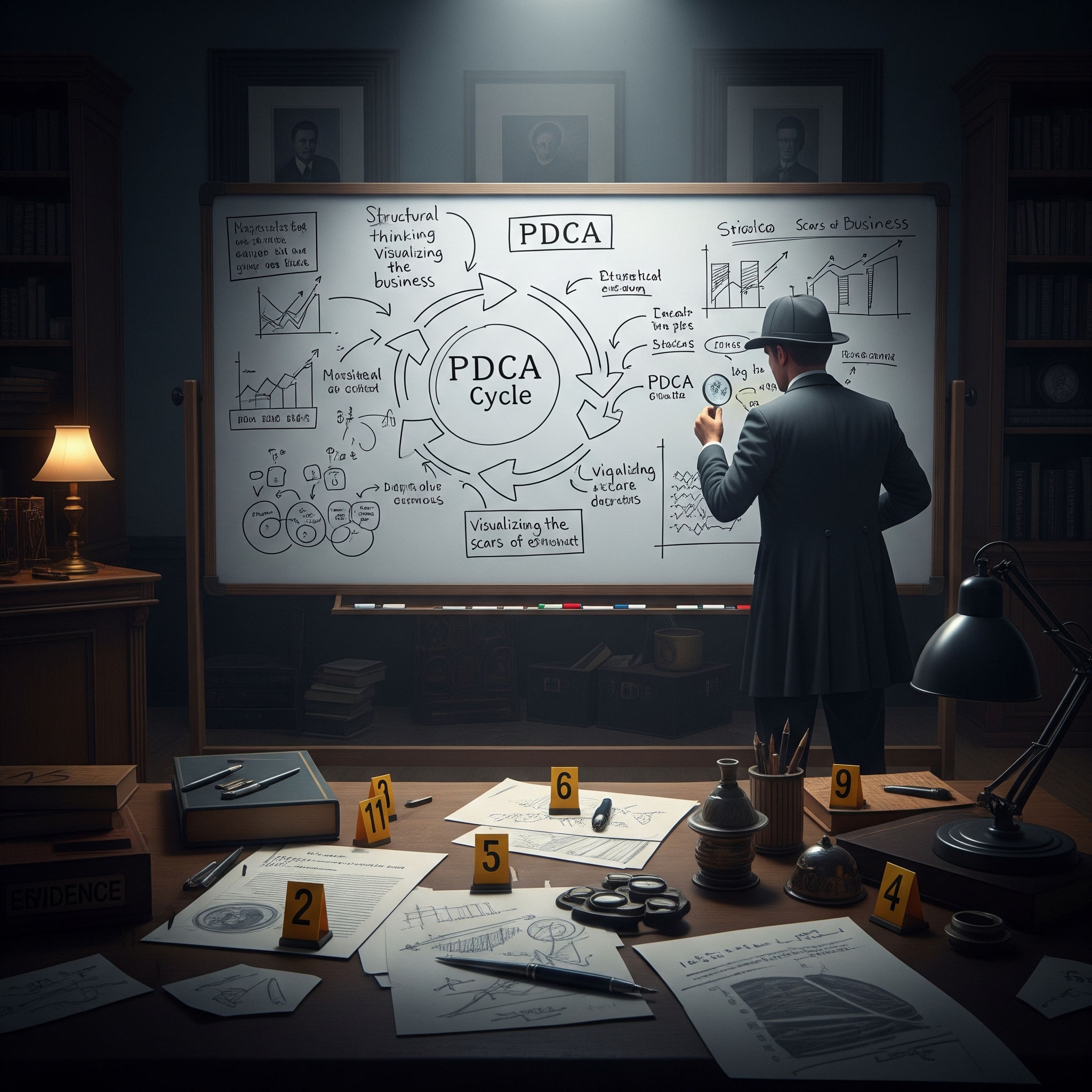【New topics】
🆕 📅 2025-06-22 Kindle book 'The Irresponsible Conspiracy' published by ROI Detective Agency.ROI Case File No. 056 | Illusion, Reality, Truth
📅 2025-06-22
🏷️ Business Efficiency 🏷️ Work Reform 🏷️ ChatGPT 🏷️ Claude 🏷️ Gemini

Chapter One: Letters Named Desperation
"The field... has reached its absolute limit."
That evening's visitor to 221B Baker Street was the clearly exhausted AdDrift Sales Director. His voice carried the urgency that comes only from managing frontline operations.
"We're an advertising and sales support company with multiple locations nationwide. We're somehow maintaining revenue. However..."
He sighed heavily.
"The workload per staff member keeps increasing annually. Most seriously, turnover won't stop. Our most capable staff are leaving one by one. At this rate, the entire organization will collapse."
In his hands were thick bundles of resignation letter copies and improvement requests from the field. "If we don't change something, we'll fall apart"—the crisis in those words was unmistakably real.
Chapter Two: The Trap Called Convenience
"A fascinating contradiction, Watson," Holmes observed, studying AdDrift's business system inventory by the fireplace. Listed were numerous "convenient tools": POS systems, attendance management, shift scheduling, daily reports, inventory management, customer management...
"Overwork is nothing but 'absence of structure,'" Holmes shook his head. "They're overwhelmed by the very 'abundance' of tools they introduced seeking efficiency."
The reality was grimmer. Each system existed independently without data integration. Staff logged into different systems multiple times daily, entered duplicate information repeatedly, and struggled with inter-system inconsistencies.
"In trying to master 'convenient tools,' they unknowingly wandered into a 'burden maze.'"
I nodded deeply. Well-intentioned system implementations ironically increasing field burden—this was a typical trap modern enterprises fall into.
Chapter Three: From Fragmentation to Integration
"What needs solving isn't the 'quantity' of work. It's the 'fragmentation.'"
Holmes stood and began diagramming current workflows on the whiteboard. What emerged were countless unconnected circles—symbols of fragmented operations.
"The true solution lies in connecting these circles with lines," his voice carried conviction.
His proposal was systematic:
Back-office Function Integration - Consolidate multiple management systems into one platform - Eliminate duplicate data entry, enable automatic integration
Front-line Automation - Paper-based checklists → Tablet digitization to reduce input errors - Shift scheduling → AI auto-suggestions with LINE integration for time savings - POS → Automatic sales-inventory linkage, seamless through order processing
"Systems are tools, not masters," Holmes turned around. "Rather than people adapting to systems, we redesign systems to support human workplace comfort."
Chapter Four: Workload Deconstruction Analysis (KPT Deduction Method)
I opened my investigation notebook to organize this complex workload structure.
✅ KPT Workload Analysis Framework:
| Category | Current Illusion | Confronting Reality | Target Truth |
|---|---|---|---|
| Keep (Values to Maintain) | • Functionality of various convenient tools • Enthusiasm and commitment to efficiency • Proactive culture of workplace improvement |
• Inter-staff field collaboration strength • Community-rooted sales approach • Careful customer service quality |
• Focus on human-centered creative work • System-supported workplace comfort • Sustainable growth foundation |
| Problem (Fragmentation to Solve) | • Illusion that more convenient tools equal efficiency • Overall inefficiency from individual optimization • Pressure to justify implementation costs |
• Burden invisibility through work subdivision • Disjointed DX implementation progress • Chain reaction of talented staff departures |
• Cost increases from lack of integrated design • Insufficient consideration for field UX • Long-term deterioration from short-term fixes |
| Try (Next Integration) | • Achieve inter-system connectivity • Fundamental elimination of duplicate tasks • Objective measurement of implementation effects |
• Comprehensive mapping and quantification of store operations • "Touchable UX" setup via LINE and specialized SaaS • Phased integration to reduce field burden |
• Human-centered business process reconstruction • Flexible systems enabling continuous improvement • Environment supporting staff growth |
"I see," Holmes nodded with satisfaction. "From illusion through reality to truth—this mirrors the detective's deduction process exactly."
Chapter Five: The Detective's Work Philosophy
"Tools exist to reduce 'burden.' But misused, they create 'new burdens.'"
Holmes picked up the shift management chart from his desk. Hand-written corrections were layered multiple times, rendering it nearly illegible.
"The true culprit in this case was 'accumulated good intentions.' Each department's individual efficiency efforts created overall inefficiency."
He stood by the window, gazing down at the street while continuing.
"The time has come to clearly redraw the boundary between 'what humans should do' and 'what should be left to machines.' Humans should concentrate on situations requiring creativity and judgment, while delegating repetitive, mechanical tasks to systems—this is true digital transformation."
I was deeply moved. Technology's purpose isn't replacing humans, but liberating human nature.
Chapter Six: The Courage Not to Try Harder
After night's silence settled over the office, I reflected on the client's confused expression.
"I can't tell staff to 'try harder.' Everyone's already working at their limit."
Those words struck at the case's core.
The harder people try, the more they reinforce environments that 'require trying harder.'
But the truth was different. Workplace comfort isn't achieved through individual effort, but through 'systems' that generate results.
What was happening at AdDrift represented a microcosm of contemporary challenges facing many companies. Countless tools introduced under digitalization were actually exhausting humans.
Yet the solution path was visible. Integrate fragmentation, simplify complexity, transform burden into support—this design philosophy is the essence of true DX.
From the illusion of convenient tools, through the reality of field exhaustion, to the truth of comfortable working environments. This detective case teaches us that technology is the means, and the goal is always human happiness.
"True efficiency is enabling humans to work humanely"—From the Detective's Journal
🔥 Weekly Top 3 Case Files


